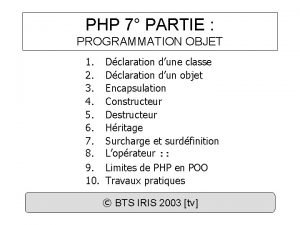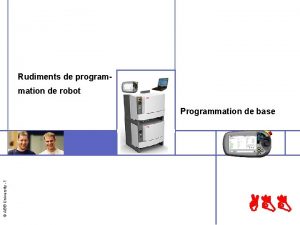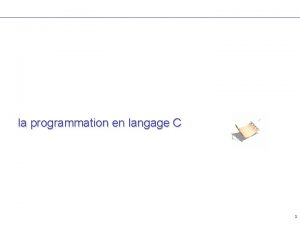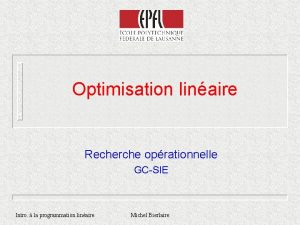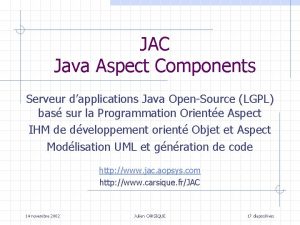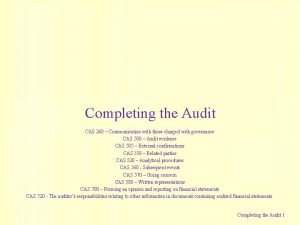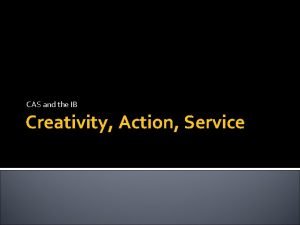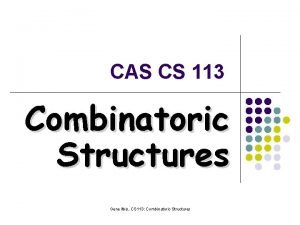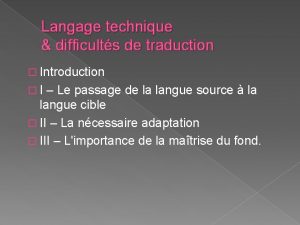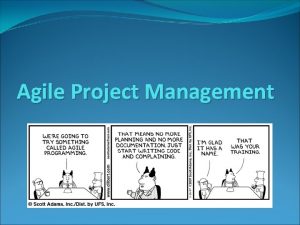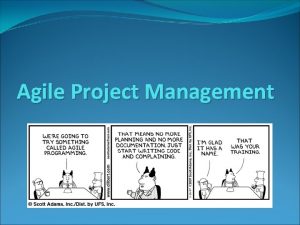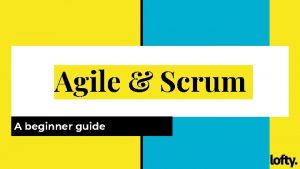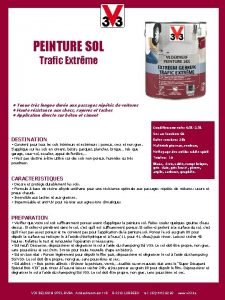Programmation agile le cas de la programmation extrme













































- Slides: 45

Programmation agile le cas de la programmation extrême Sylvain Giroux October 3 rd, 2000

Plan Quel est le problème à résoudre ? XP: qu’est-ce ? pourquoi et quand l’appliquer ? “X” ? Méthodologie logicielle Variables Valeurs Règles Pratiques Références

Le problème fondamental : le risque Développement du logiciel Échoue à livrer le logiciel, Échoue à produire un logiciel ayant une valeur. l l l l Glissements des échéanciers Annulation de projets Le système est dépassé Quantité de défauts, bugs, etc. Incompréhension ou changements des pratiques d’affaires Des fonctionnalités puissantes, mais sans intérêt Roulement de personnel

Méthodologie logicielle Une méthodologie logicielle est un ensemble de règles et de pratiques utilisées pour créer des logiciels. Une méthodologie “lourde” possède plusieurs règles, pratiques et documents. Elle requiert de la discipline et du temps pour l’appliquer correctement. l Rational Unified Process (1491 fichiers dans 159 dossiers, en 2000) Une méthodologie “légère” a peu de règles et de partiques, qui sont faciles à appliquer.

Programmation extrême Une discipline pour le développement de logiciel pour de petites équipes (2 -10 personnes) afin de développer un logiciel rapidement dans un environnements où les besoins et les spécificatiosn changent rapidement.

Objectif de XP Livrer le logiciel dont on a besoin lorsqu’on en a besoin.

Quand utiliser XP? Domaines pour lesquels les besoins changent / évoluent On ne possède pas une idée claire / définitive de ce que le système doit faire On s’attend à des changements fréquents des fonctionnalités du système (de l’ordre de quelques mois). Pour gérer les risques liés au projet. Si le client a besoin d’un nouveau système à une date spécifique, le facteur de risque est grand. Si le système présente de nouveaux défis pour l’équipe de développement, le facteur de risque est encore plus grand. Si le système présente de nouveaux défis pour l’ensemble de

Quand utiliser XP? XP exige une équipe de développement étendue Les développeurs Les gestionnaires Les clients Pourquoi ? Poser des questions, Négocier la portée et les échéanciers, Créer des tests fonctionnels

Tests Unit Test: A test of one component of the system. Contrast with "system test. " Functional tests: Testing software based on its functional requirements. It ensures that the program physically works the way it was intended and all required menu options are present. It also ensures that the program conforms to the industry standards relevant to that environment; for example, in a Windows program pressing F 1 brings up help. Regression Test: To test revised software to see if previously working functions were impacted. System Test: Overall testing in the lab and in the user environment. See alpha test and beta test. Acceptance Test: The test performed by users of a new or changed system in order to approve the system and go live. Cosmetic and other small changes may still be required as a result of the test, but the system is considered stable and processing data according to requirements. Test Case: A set of test data, test programs and expected results. Test Scenario: A set of test cases that ensure that the business process flows are tested from end to end. Black Box Test: Testing software based on output only without any knowledge of internal operation. Contrast with "white box test. "

Quand utiliser XP? “Testabilité” du logiciel Productivité Les projets XP démontrent une plus grande productivité des développeurs lorsqu’elle est comparée à des projets similaires appartenant au même domaine corporatif.

Pourquoi “extrême” ? -- I Si la revue de code est une bonne pratique, la revue de code sera réalisée en permanence (programmation par paires). Si les tests sont importants, tous vont écrire des tests tout le temps (tests unitaires), même les clients (tests fonctionnels) Si le design est important, le design sera partie intégrante de la pratique de tous les membres (refactorisation) Si la simplicité est une qualité à recher, le système utilisera toujours le design le plus simple possible capable de supporter les fonctionnalités courantes (le plus simple qui puisse possiblement fonctionner).

Pourquoi “extrême” ? -- II If architecture is important, everybody will work defining and refining the architecture all the time (metaphor) If integration testing is important, we’ll integrate and test several times a day (continuous integration). If short iterations are good, we’ll make the iterations really, really short –seconds and minutes and hours, not weeks and months and years (the Planning Game).

Four Variables We will control four variables in our projects Cost Time Quality Scope External forces (customers and managers) get to pick the values of 3 of the variables. The development team gets to pick the resultant value of the 4 th variable.

Values XP is based on Communication Simplicity Feedback Courage.

Value : communication Problems with projects can invariably be traced back to somebody not talking to somebody else about something important A programmer doesn’t tell someone else about a critical change in the design A programmer doesn’t ask the customer the right question, so a critical domain decision is blown A manager doesn’t ask a programmer the right question, and project progress is misreported

Value : communication and XP Practices XP practices that can’t be done without communication Unit testing Pair programming Task estimation

Value : simplicity What is the simplest thing that could possibly work? Not to look toward the things you’ll need tomorrow and next week and next month XP stance: It is better to do a simple thing today and pay a little more tomorrow to change if it needs it, than to do a more complicated thing today that may never be used anyway

Value : simplicity and XP Practices The more you communicate, the clearer you can see exactly what needs to be done and the more you have confidence about what really doesn’t need to be done The simpler your system is, the less you have to communicate about Practices Simple design Refactoring

Value : Feedback at scale of minutes and days Concrete feedback about the current state of the system Don’t ask me, ask the system Feedback for customers When customers write new stories (description of features), the programmers immediately estimate them Feedback on project progress Watching the completion of tasks to give the whole team feedback about whether they are likely to finish everything they set out to do in a span of time

Value : Feedback at scale of weeks and months The customers and testers write functional tests for all the stories (simplified use cases) implemented by the system. The customers review the schedule every two or three weeks to see if the team’s overall velocity matches the plan, to adjust the plan The system is put into production as soon as it makes sense, so the business can begin to “feel” what the system is in action and discover how it can best be exploited.

Value : Feedback and XP practices The more feedback you have, the easier it is to communicate Simple systems are easier to test XP practices The planning game Small releases Testing Pair programming Continuous integration On-site customer

Value : Courage to take decisions Radical surgery on code Throwing code away Starting over from scratch Prototyping multiple design alternatives, and keep only one for “real” development

Last but not least Respect

Principles From the 4 values, a dozen or so of principles (rules) are derived to guide the development style

Central Principles Main principles Rapid feedback l time between action and feedback is critical Assume simplicity Incremental change l Big change made all at once just don’t work Embracing change l Preserves the most options while solving the most pressing problem Quality work

Less central principles Teach learning No doctrine Small initial investment Too many resources too early in a project is a recipe for disaster Play to win Playing to win vs playing not to lose l For sure we need to write reports, … but getting a working system is more important… Concrete experiments Every time you made a decision and you don’t test it,

Less central principles Open, honest communication Able to tell each other where there are problems in the code Able to express fears and get support Free to deliver bad news to customers and management, to deliver it early, and without being punished Work with people’s instincts, not against them XP is a process where following short-term self-interest (win, learn, be in control, good work…) also serves long-term team interest Accepted responsibility Not telling people what to do Does not mean that you always do exactly what you feel like

Less central principles Local adaptation Adapt XP principles and practices to local conditions Travel light You can’t expect to carry a lot of baggage and move fast Be prepared to change direction Artifacts l l l Few Simple Valuable Honest measurement

Back to basics There are 4 activities to support Coding Testing Listening Designing

XP Practices What is a practice? the usual way of doing something Aim of practices in XP: Structure the 4 activities In XP, there are 12 practices

12 Practices The Planning Game Small Releases. Metaphor. Simple Design. Testing. Refactoring. Pair Programming. Collective Ownership. Continuous Integration. 40 -hour Week. On-site Customer. Coding Standard.

Practice: The Planning Game Determine what will be accomplished by the due date, determining what to do next The XP "customer“ define the business value of desired features The programmer provides cost estimates The XP "customer“ choose l what needs to be done l what needs to be deferred

Practice: Small releases XP teams put a simple system into production early, update it frequently on a very short cycle

Practice: Metaphor XP teams use common "system of names" and a common system description that guide development and communication We don’t literally mean “the system is…” Give everyone a coherent story within which to work Help everyone on the project understand the basic elements and their relationships "this program works like a hive of bees, going out for pollen and bringing it back to the hive" as a description for an agent-based information retrieval system

Practice: Simple design A program built with XP should be the SIMPLEST program that meets the current requirements. There is not much building "for the future".

Practice: Testing XP teams focus on validation of the software at all times. Programmers develop software by writing tests first, then software that fulfills the requirements reflected in the tests. Customers provide acceptance tests that enable them to be certain that the features they need are provided.

Practice: Refactoring XP teams improve the design of the system throughout the entire development removal of duplication (a sure sign of poor design), on increasing the "cohesion" of the code, while lowering the "coupling". High cohesion and low coupling have been recognized as the hallmarks of well-designed code for at least thirty years This is done by keeping the software clean without duplication with high communication simple yet complete

Practice: Pair Programming XP programmers write all production code in pairs, two programmers working together at one machine

Practice: Collective ownership All the code belongs to all the programmers This lets the team go at full speed, because when something needs changing, it can be changed without delay

Practice: Continuous integration XP teams integrate and build the software system multiple times per day This keeps all the programmers on the same page, and enables very rapid progress integrating more frequently tends to eliminate integration problems that plague teams who integrate less often

Practice: 40 -hour week (sustainable pace) Tired programmers make more mistakes. XP teams do not work excessive overtime, keeping themselves fresh, healthy, and effective This means that they work overtime when it is effective, and that they normally work in such a way as to maximize productivity week in and week out.

Practice: On-site customer An XP project is steered by a dedicated individual who is empowered to determine requirements, set priorities, answer questions as the programmers have them

Practice: Coding standards to work effectively in pairs, to share ownership of all the code, all the programmers need to write the code in the same way with rules that make sure the code communicates clearly

XP map A spike solution is a very simple program to explore potential solutions

References Kent beck, Extreme Programming Explained: Embrace Change, Addison Wesley, 2000 Martin Fowler, Refactoring : Improving the Design of Existing Code, Addison-Wesley, 1999 http: //www. xprogramming. com/xpmag/index. htm http: //www. xprogramming. com/Practices/xpractices. htm http: //www. extremeprogramming. org/
 Programmation agile
Programmation agile Programmation
Programmation Programmation lineaire
Programmation lineaire Webavance
Webavance Programmation objet php
Programmation objet php Planification annuelle football
Planification annuelle football Programmation lineaire
Programmation lineaire énuméré synonyme
énuméré synonyme Programmation procédurale vs orienté objet
Programmation procédurale vs orienté objet Tableau go
Tableau go Scheme programmation
Scheme programmation Théorème des écarts complémentaires
Théorème des écarts complémentaires Robtarget
Robtarget Programmation
Programmation Michel bierlaire
Michel bierlaire Java aspect
Java aspect Problème de transport en programmation linéaire
Problème de transport en programmation linéaire Ladder elements
Ladder elements Monitor de siembra controlagro
Monitor de siembra controlagro Cas
Cas Cas 260
Cas 260 Slovesa
Slovesa Místní čas příklady
Místní čas příklady Hlavňový vrták
Hlavňový vrták Language
Language Průměrná rychlost vzorec
Průměrná rychlost vzorec Ias cas
Ias cas Cas vos gedigte
Cas vos gedigte Cas public management
Cas public management Cas definition ib
Cas definition ib Fliegen minulý čas
Fliegen minulý čas Cas concret infirmier
Cas concret infirmier Zloin
Zloin Cas mpips
Cas mpips Ipard cas
Ipard cas Carevo novo odelo priprema za cas
Carevo novo odelo priprema za cas Sysml cas d'utilisation
Sysml cas d'utilisation Cas d utilisation
Cas d utilisation Combinatoric structures
Combinatoric structures Fgcu engineering advising
Fgcu engineering advising Prenons le cas
Prenons le cas Cas bildnerisches gestalten
Cas bildnerisches gestalten Dram ras cas
Dram ras cas Cas juridique
Cas juridique Improving web application security
Improving web application security Diagramme de classe exemple
Diagramme de classe exemple




